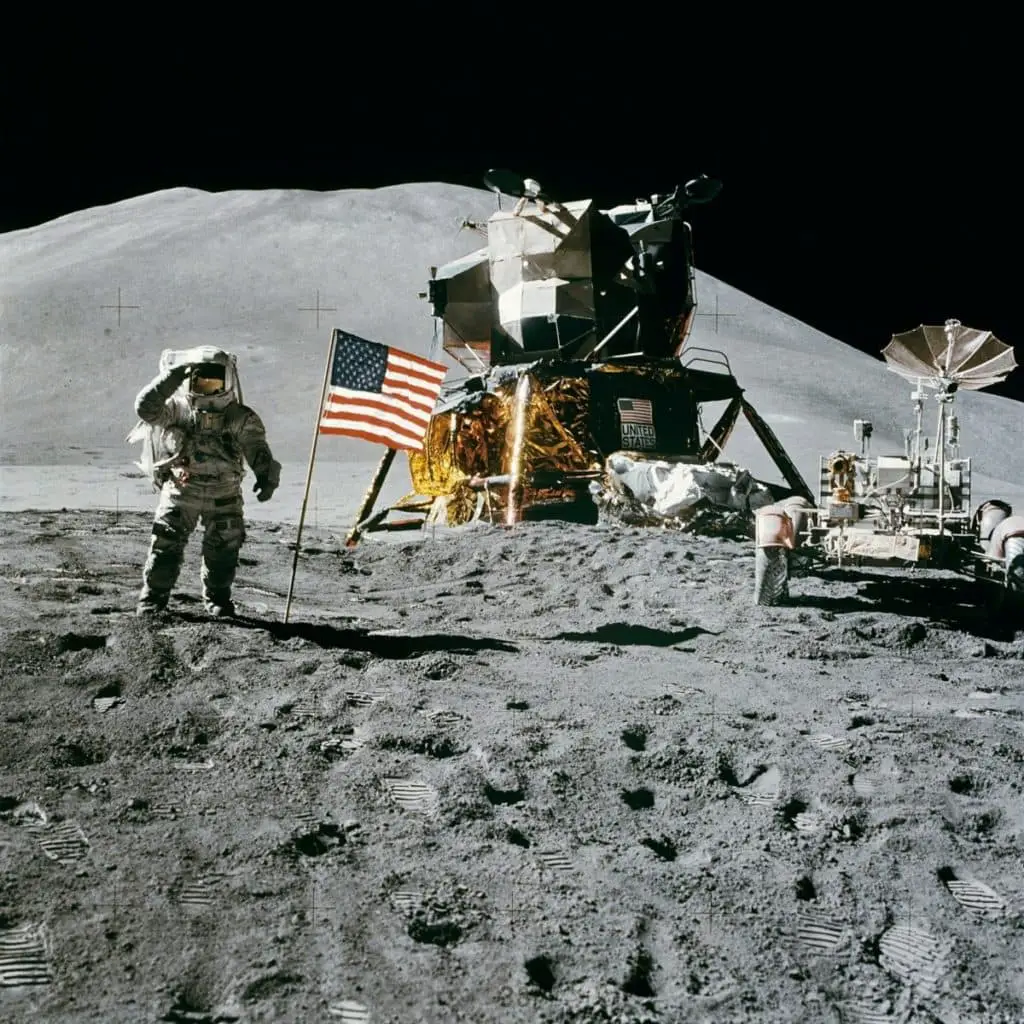
Lunar exploration has not been at the top of our bucket list in recent years. More pronounced efforts have been directed at resupplying the International Space Station, Mars, the production of low-cost rockets and cost-effective access to low-Earth orbit, space tourism, etc., it seemed like the moon has slipped out of our view. But finally, things are about to change.
The exploration of the moon will not only inspire future generations with new knowledge and opportunities but also serve as a testing ground for technologies that will enable human exploration of Mars and beyond.
Let’s take a look at what we are doing to achieve those ends!
Why is exploration on the Moon so important?
It is important to inspire the future generations to pick up the torch and innovate for the future of space exploration, but what new knowledge can we actually obtain from the moon, and how would they benefit us?
A paper (1) from the Journal of Planetary and Space by Crawford et. al helps us to understand the scientific rationale for resuming lunar surface exploration.
Geological Information
The moon is unique in that as one of the closest celestial bodies to the Earth, it has a lack of recent geological activity and active erosional process. This becomes essential as its extremely ancient surface (3 – 4.5 billion years old) has been left unscathed (except for the asteroid impact craters here and there), which gives us access to a near-surface environment that has preserved lunar geological records.
These geological records could tell us the process of evolution for terrestrial planets, which planets with a relatively more complex ecosystem like Earth, Venus, and Mars have long lost. The examination of the Moon’s outer layers will also allow us to gain a record for the cosmic environment of the inner solar system throughout its history. This can be accomplished by analyzing meteorite flux, interplanetary dust density, solar wind flux, and compositions, etc.
The structure and composition of the moon’s interior are also of particular interest, as its lack of plate tectonics allowed the lunar crust and mantle to remain separated for more than 4 billion years. This in part allowed the moon to retain early records of differentiation processes (e.g., thermal evolution, the composition of its core, etc.) that other more evolved planets have lost.
This is only the tip of the iceberg to what we could uncover on the Moon. By understanding the origin and evolution of the solar system and its planets, we begin to build a reference for the type and characteristic of planets and systems that has the possibility to preserve life or become a secondary candidate for colonization.
Other objectives for lunar exploration include the opportunities for research in astronomy, astrobiology, fundamental physics, life sciences, human physiology and medicine.
Life Science and Astrobiology
In the case of life sciences and astrobiology, it is very possible for the lunar surface to contain early Earth material in the form of rocks that were ejected by comets and asteroids that made their landing on Earth. This provides us with evidence to determine the type of environment life might have evolved under on our planet. The lunar environment also contains the crashed remains of unsterilized space crafts, and the bacterial spores may be collected and examined for DNA and other biochemical damage from their time in a lunar environment.

From the perspective of human physiology and medicine, the gravity we experience on Earth largely impacts and modulates many of the human body’s biological processes. In a microgravity condition, most of our physiological systems have been known to adapt, which paired with routine exercise regimes, nutritional balance, as well as behavioral support, can alleviate most of the negative effects of living in space. However, many astronauts do encounter problems upon return, as the programs developed to counteract the effects of microgravity do not fully prevent the human body from de-conditioning, whether it be spatial orientation, cardiovascular, musculoskeletal, or otherwise. That’s why the recommended stay on the ISS is currently 6 months.
Monitoring human adaptations under prolonged exposure to partial gravity, such as the moon, would grant us significant insights into how gravity or its lack of might affect biological processes. A lunar research base would give us a more tightly controlled environment in terms of micro/partial gravity exposure.
Gravity aside, life support has always been one of the greatest concerns for prolonged space travel. What use is a light speed engine if we are not able to survive long enough to use it? Life support in this manner would entail bio-regenerative food, breathable air, closed-loop water systems, medical support, etc., which can be further explored from human operations in a lunar base.
Astronomy
With almost the entire electromagnetic spectrum being used to study the universe, scientists can study the different physical processes that relate to the different frequencies. But how would having telescopes on the moon help us see deeper into the cosmos?
For starters, telescopes are becoming increasingly more powerful and sensitive, which raises the requirement for telescope sites. Not only do we need to steer clear of light pollution, but different detectors are also sensitive to different wavelengths of light, and not all light can get through the Earth’s atmosphere. With that being said, aside from installing telescopes aboard satellites, the next logical step would be to set up observation sites on the moon. The deeper we can peer into the universe, the more we learn about its past.
Technology
The moon remains a testing ground for technology that could help humans survive in the endless vacuum of space. Such an environment contains threats including “high radiation, altered gravity regimes, the presence of biologically and mechanically aggravating dust, and difficulties in acquiring liquid water and gases to breathe”.
But most importantly, the technology to bring not only robotics, but humans to the Moon will benefit humanity for generations to come. Not only in the data we can collect, but its purpose as a testing ground for traveling to Mars and beyond.
When was the last time humans went to the moon?
Taking place on 20 July 1969, NASA’s Apollo 11 was the first manned mission to the moon.
‘That’s one small step for man, one giant leap for mankind”
Neil Armstrong
Consequently, a total of twelve men have landed on the moon during the course of six NASA missions across a 41-month period. The last manned mission to the moon ended with NASA’s Apollo 17 on 14 December 1972, piloted by Jack Schmitt and Gene Cernan, who was also the last man to step off the lunar surface.
Which countries are trying to get on the moon?
Countries that have already sent remote sensing spacecrafts to lunar orbit (not flyby missions or landers… Orbiters!) in the past two decades (1) include the European Space Agency: SMART-1 (2004); Japan: Kaguya (2007); China: Chang’e-1 (2007), Chang’e 2 (2010), Chang’e 5-T1 (2015), Longjiang-2 (2018), Chang’e 5 (2020); India: Chandrayann-1 (2008), Changdrayann-2 (2019); and the USA: lunar reconnaissance orbiter (LRO) (2009), ARTEMIS (2011), GRAIL (2012), LADEE (2013).
Aside from orbiters, no country has successfully returned samples from the moon since Russia’s Luna 24 mission in August 1976… That is until China’s successful launch of Chang’e 5 in December 2020, which autonomously obtained and transferred lunar samples to a return capsule in lunar orbit.
What are we doing now?
Artemis Program (USA/NASA)
The Artemis program is NASA’s efforts to lead humanity forward to the moon and prepare us for the next giant leap to Mars. This plan aims to accomplish two things: Initial human landing on the moon by 2024 with acceptable technical risk, and sustainable lunar exploration in the mid-to-late 2020s.
As part of the Artemis plan, NASA hopes to “build operational confidence for conducting long-term work and supporting life away from Earth on the moon before we can embark on the first multi-year human mission to Mars.
There are 6 components that is integral to the success of the program:
1) Exploration Ground System
The foremost priority for the Artemis program is the establishment of the supporting Exploration Ground Systems (EGS). Based at NASA’s Kennedy Space Centre in Florida, EGS develops and operates the systems and facilities necessary to process and launch rockets and spacecraft during assembly, transport, and launch (NASA).
For the success of the Artemis program and the long-term sustainability and affordability of future processing and launch, the EGS is preparing infrastructure to support different kinds of rockets and spacecrafts in development. This includes the upgrade of LaunchPad 39B, which is especially important as it has been modified to make the area a “clean pad”, which allows a variety of rockets to launch, both government and commercially owned. Such spacecrafts might include NASA’s Space Launch System (SLS) rocket and Orion’s spacecraft for Artemis I.
2) Space Launch System
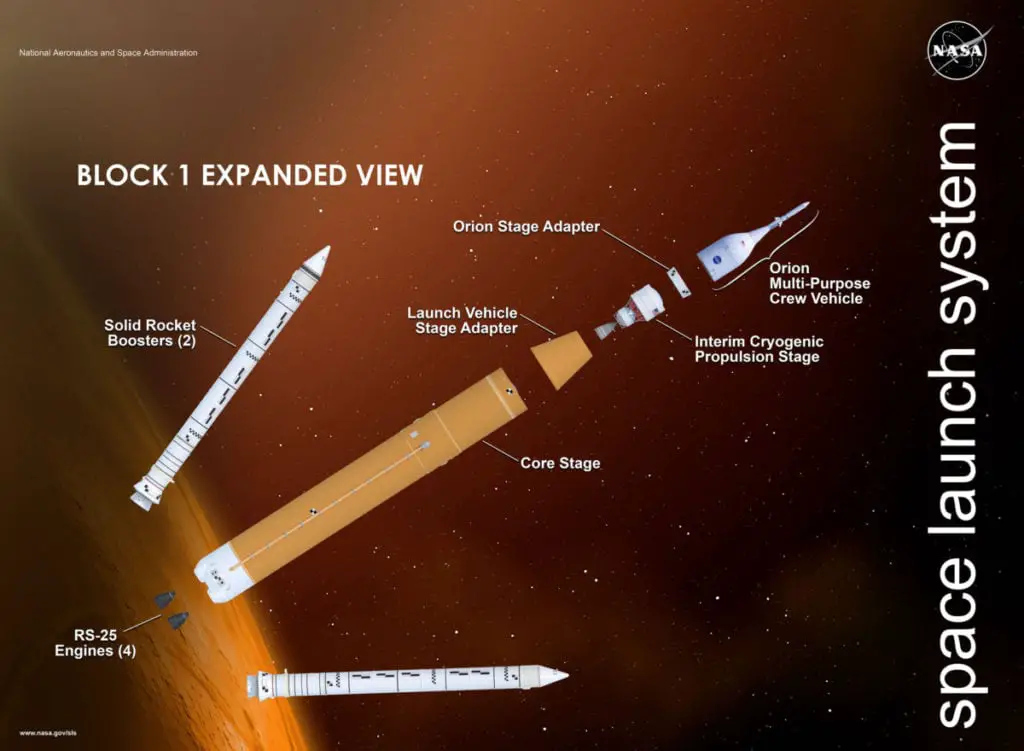
The Space Launch System (SLS) might sound like a series of infrastructure to support the launch of rockets and spacecrafts. But on the contrary, it will actually be the most powerful rocket NASA has ever built. When the SLS takes off on its first flight for the Artemis program (named the Artemis I), it will produce a maximum of 8.8 million pounds of thrust to deliver the Orion spacecraft into lunar orbit (NASA).
3) Orion
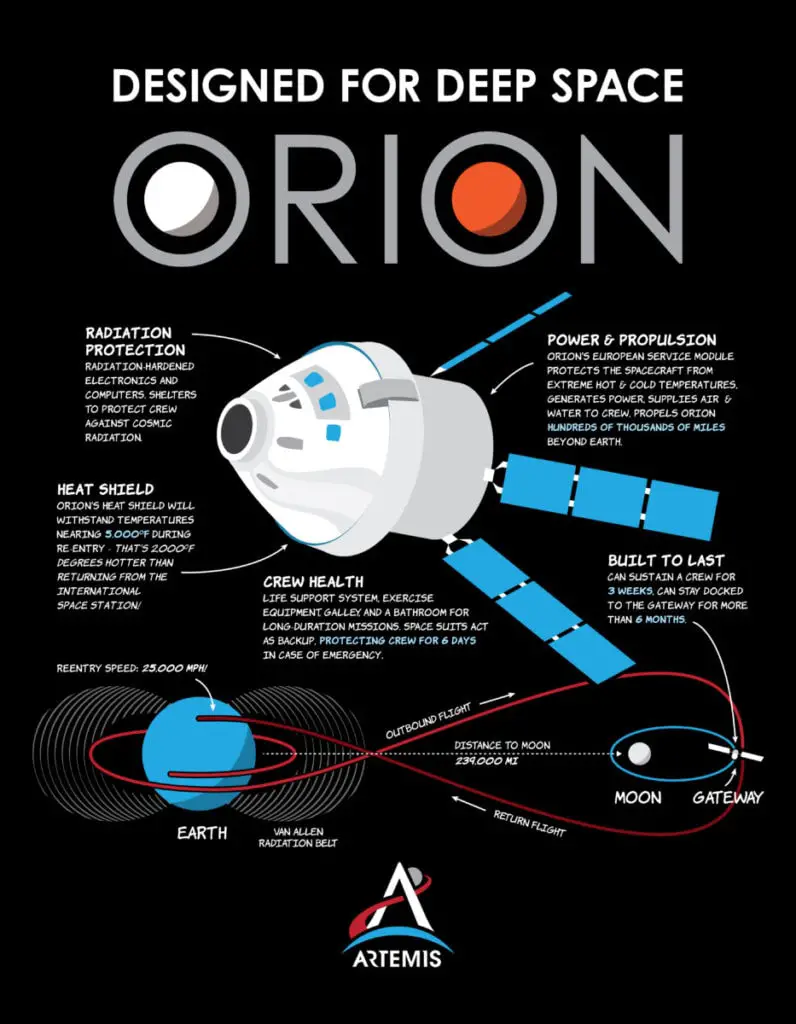
Image by NASA 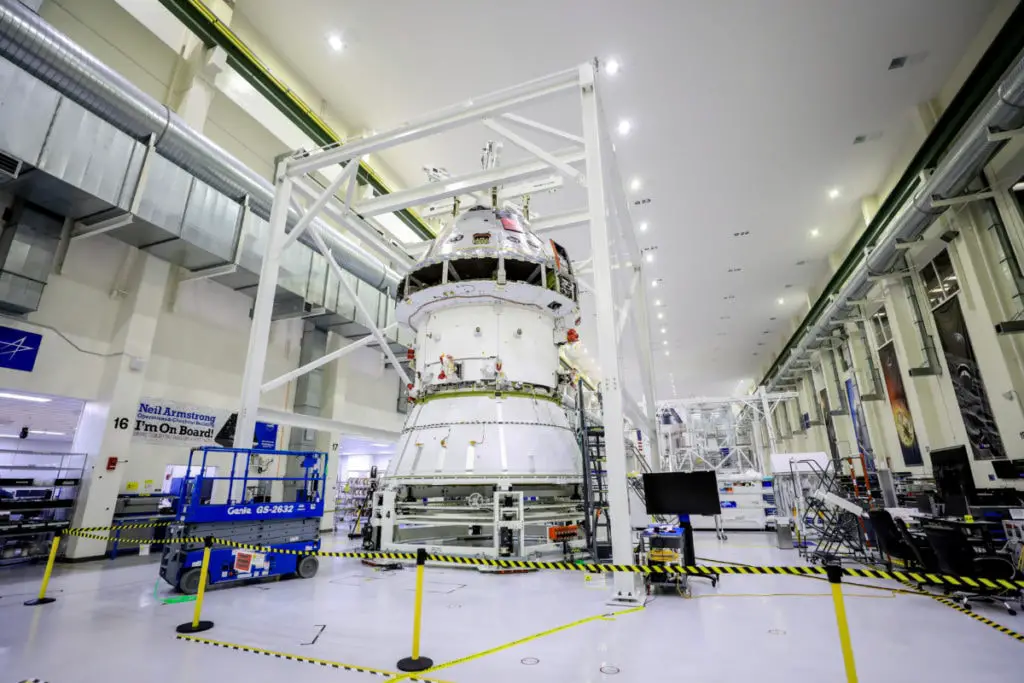
Image by NASA
In 2024, Orion is the name of the spacecraft that will deliver its crew into lunar orbit, to which the commercially developed human landing systems will take the crew down onto the lunar surface. Powered by a service module provided by the ESA, Orion is designed for deep-space human operations for up to four crew members.
With Orion’s first test flight aboard the SLS before Artemis I, it will have theoretically travelled more than 1.4 million miles prior to returning to Earth, which surpasses the distance set by Apollo 13 for the longest distance travelled from Earth in a spacecraft designed for humans.
4) Gateway
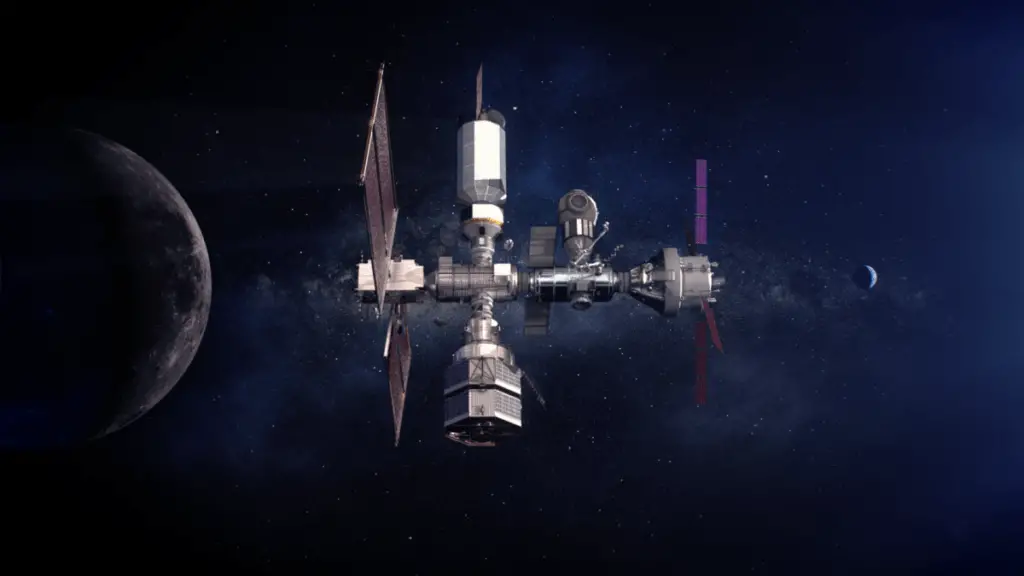
Gateway, unlike its name suggests, is unfortunately not the doorway to another dimension, but an outpost around the moon. The success of Gateway as a sustainable lunar outpost will serve as a future model for missions to Mars. The Gateway in the long term will become a port for deep space transportation and a hub for astronaut expeditions and scientific investigation.
The Habitation and Logistics Outpost or HALO of the Gateway will be the initial crew cabin for visiting astronauts. HALO will provide the basic life support needed for astronauts after they arrive in Orion and prepare for their trip to the lunar surface (NASA).
5) Lunar Landers
NASA has selected the companies Blue Origin (founded by Jeff Bezos), SpaceX (founded by Elon Musk), and Dynetics (a Leidos company) to begin development for the Human Landing System (HLS), which will land astronauts on the Moon and safely return them into lunar orbit. Three distinct lander and mission designs have been proposed:
- The Blue Origin-led team offers an Integrated Lander Vehicle (ILV), which is a three-stage lander composed of an ascent, descent, and transfer element that will launch on Blue Origin’s New Glenn rocket, and United Launch Alliance’s (ULA) Vulcan heavy-lift rocket.
- The Dynetics Human Landing System uses a single element to provide both ascent and descent capabilities, whilst utilizing a separate module – modular propellant vehicles (MPVs) for refueling at different positions in the mission. Both the lander and the MPVs will be launched on ULA’s Vulcan heavy-lift rockets.
- SpaceX’s Starship is a fully reusable launch and landing vehicle designed for the Moon and beyond. Launched aboard the SpaceX Super Heavy Rocket, the Starship’s two-stage to orbit design allows it to refuel in low-Earth orbit before making its way to lunar orbit.
6) Artemis Generation Spacesuits
Remember those chunky space suits that look like it came right out of a commercial with the Michelin Tire Man? Well, those days are no more.

On the surface of the moon, the crew will wear their new exploration extravehicular mobility unit (xEMU) spacesuits during exploration. The xEMU will be able to afford more frequent spacewalks with improved safety, custom fitting, simplified maintenance, and better communication.
During launch and re-entry, the astronauts will be wearing the Orion crew survival system suit.
With the Artemis program, NASA hopes to pave the way for a new and sustainable lunar economy, where private and international partners can learn and build from what has been accomplished.
CE-7 Mission (China)
The approach to future Chinese lunar programs has not been laid out or is it as sophisticated as the U.S. Artemis program, but China is determined to land its astronauts on the moon and set up a scientific station.
Zhou Yanfei, the deputy general designer of China’s human spaceflight program told Chinese media that Chinese researchers will have to overcome a long list of technical and engineering difficulties to put Chinese astronauts on the moon, which include a more powerful carrier rocket, construction of a lunar landing capsule, a better ground support system designed for operations on the lunar surface, and training/experience for the astronauts to work on an extraterrestrial body.
It is hopeful for a robotic scientific research station prototype to be built on the south pole of the Moon by 2035 (2). In the meantime, China aims to continue its Chinese Lunar Exploration Program (CLEP) with the Chang’e 7 (CE-7) mission scheduled for 2024, with its primary purpose being to obtain scientific information regarding lunar inner ring structure, distribution, and source of lunar water and volatiles, research of the space environment such as lunar surface magnetic field, etc. (2)
Chandrayaan-3 (India)
Unfortunately, not all countries have the scientific and economic prowess to develop space programs capable of sending humans to the moon.
The Indian Space Research Organization (ISRO) is one of the up-and-coming space agencies that have been making efforts to conduct a soft lunar landing after the administration of the USSR, NASA, and CNSA. The success of the Chandrayaan-3 with a proposed launch date of late 2021 to early 2022 will make India the 4th country to soft-land on the moon.
References
- Crawford, I. A., Anand, M., Cockell, C. S., Falcke, H., Green, D. A., Jaumann, R., & Wieczorek, M. A. (2012b). Back to the Moon: The scientific rationale for resuming lunar surface exploration. Planetary and Space Science, 74(1), 3–14. https://doi.org/10.1016/j.pss.2012.06.002
- Zou, Y. L., Liu, Y., & J, Y. Z. (2020). Overview OF China’s Upcoming Chang’e Series and the Scientific Objective and Payloads for Chang’e-7 Mission. 51st Lunar and Planetary Science Conference.
